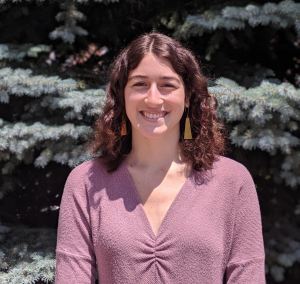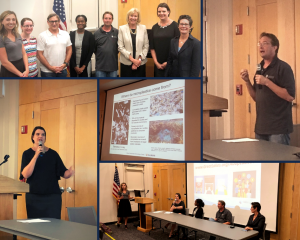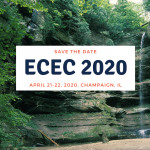 Dan Marsch, an environmental engineer with ISTC’s Technical Assistance Program, provides pollution prevention technical assistance to industrial facilities in Central Illinois with particular focus upon source reduction, raw material conservation, and waste minimization.
Dan Marsch, an environmental engineer with ISTC’s Technical Assistance Program, provides pollution prevention technical assistance to industrial facilities in Central Illinois with particular focus upon source reduction, raw material conservation, and waste minimization.
He is the Principal Investigator of ISTC’s long-running Illinois Conservation of Resources – Economy, Energy and Environment (ICORE3) project, through which currently focuses on Illinois’ food and beverage manufacturers.
He has been with ISTC since 2002.
How old were you when you first became interested in sustainability? What sparked your interest?
My father passed down to me respect and reverence of nature. As far back as I can remember, I’ve been an outdoorsman and have enjoyed nature’s offerings, primarily fishing, as a youngster with my father, continuing into adulthood, as a father with my children, and hopefully one day with my grandchildren.
As a child, I was an avid reader of The Missouri Conservationist, a monthly publication of the MO Dept. of Conservation, as well as a variety of hunting and fishing magazines.
Who or what drew you to study sustainability?
For me, it was later in life. I may have been naïve, but to be an environmentalist, I thought I had to be a field biologist, researcher, park ranger or such. Back then, the options were limited, unlike today. So I went a different career path.
But after a 20 year career in sales, distribution and manufacturing, I felt a void. I lacked passion for what I was doing and contributing to society. I was asking myself some tough, life-changing questions. What was I going to leave behind to the next generation? What would I like to do vs. have to do? How and where would I make my mark in life. It was time for me to make a career and life change.
Building upon my prior education and work experience in industry, I came to work at WMRC’s (now ISTC) Technical Assistance Program in 2002 and finally found my passion and my lot in life. I’m still an environmentalist but my office has changed. I usually say that I work upstream of the environment. I work with industry to prevent pollution and its impact.
What is the best part of your job at ISTC and what work are you most proud of?
The best part [of my job] is helping others [by] being a change-agent and helping my clients save money, reduce their environmental footprint and being more socially responsible. Making a difference in their lives, their business and their community.
The most interesting part of my job is the vast variety of products that I see being manufactured in Illinois. Everything from hammers to hair dryers, cookies to car parts, and how things are made, the processes and skill levels of our Illinois workforce.
I’m most proud of the impact of my Illinois Conservation of Resources and Energy (ICORE) project within Illinois businesses, from 2008 to present.
Some ICORE statistics:
- 168 participants
- $40M saved
- 24 M gallons water saved
- 343,000 MTCO2e reduced
Mike Springman and I received the National Pollution Prevention Roundtable’s 2013 MVP2 Award for ICORE.
What’s your favorite work-related memory?
I was at a slaughterhouse and meat processor who had an anaerobic covered lagoon that generated methane gas, captured by a large multi-ply black rubber membrane and piped to a scrubber for use as fuel in its gas boilers.
The membrane was inflated and bulging from the methane gas.
They invited me to jump on the membrane, which I did (are you kidding, why not? It looked fun). There I was bouncing up and down like a kid in a bouncy room.
Then it occurred to me, and I asked the question: “How deep is this lagoon of sh#@?”
What are common misconceptions about your career? OR What question do you get asked most frequently about your career or the subject you study?
The most frequent questions are, “Are you EPA?,” “What are you selling?,” “Are there state or federal monies available?”, “How am I going to pay for it?”
My replies: We are not EPA, OSHA, ICE or the police. I sell change. I help companies save money, reduce their environmental footprint and be more socially responsible. And, yes there are external incentives available.
What are some challenges you’ve faced in your career?
Keeping the passion and drive alive.
You have to love what you do, because so much of who we are comes from what we do. We spend a significant portion of our lives working, so why not find a career that you enjoy doing.
Aside from the strength that I get from my faith and my family, I find meaning and purpose in my work and from the lives that I touch.
What do you wish more people understood about sustainability or being a sustainability professional?
Sustainability is more than a feel-good thing, more than a marketing venture or item for your sustainability report. It’s a commitment and a lifestyle.
I try to show my clients that sustainability makes sense and it’s the right thing to do. There’s a business-case for sustainability: the triple-bottom line (people, planet, profit).
What advice would you give to future sustainability professionals?
Find your niche, something that you love and do it. Be persistent and don’t give up or give in. Be yourself and be genuine. Understand that people don’t care how much you know. They want to know how much you care.
Don’t take it personally or get discouraged when your client doesn’t take your advice or implement the “no-brainer” that you recommended. Remember the old adage, “you can lead a horse to water but can’t make him drink.”
If you could switch jobs with someone, who would it be?
A western actor. The only problem is that I can’t ride a horse, remember lines or smoke a hand-rolled cigarette. And I’m not a quick-draw. I’m a huge western movie buff, circa 1940’s – 1960’s including, Wayne, Eastwood, Fonda, Stewart, Ford (John and Glenn), Scott, and the list goes on.




 ISTC was one of several expert organizations invited to provide information on microplastics at a public meeting hosted by
ISTC was one of several expert organizations invited to provide information on microplastics at a public meeting hosted by 
 The
The 